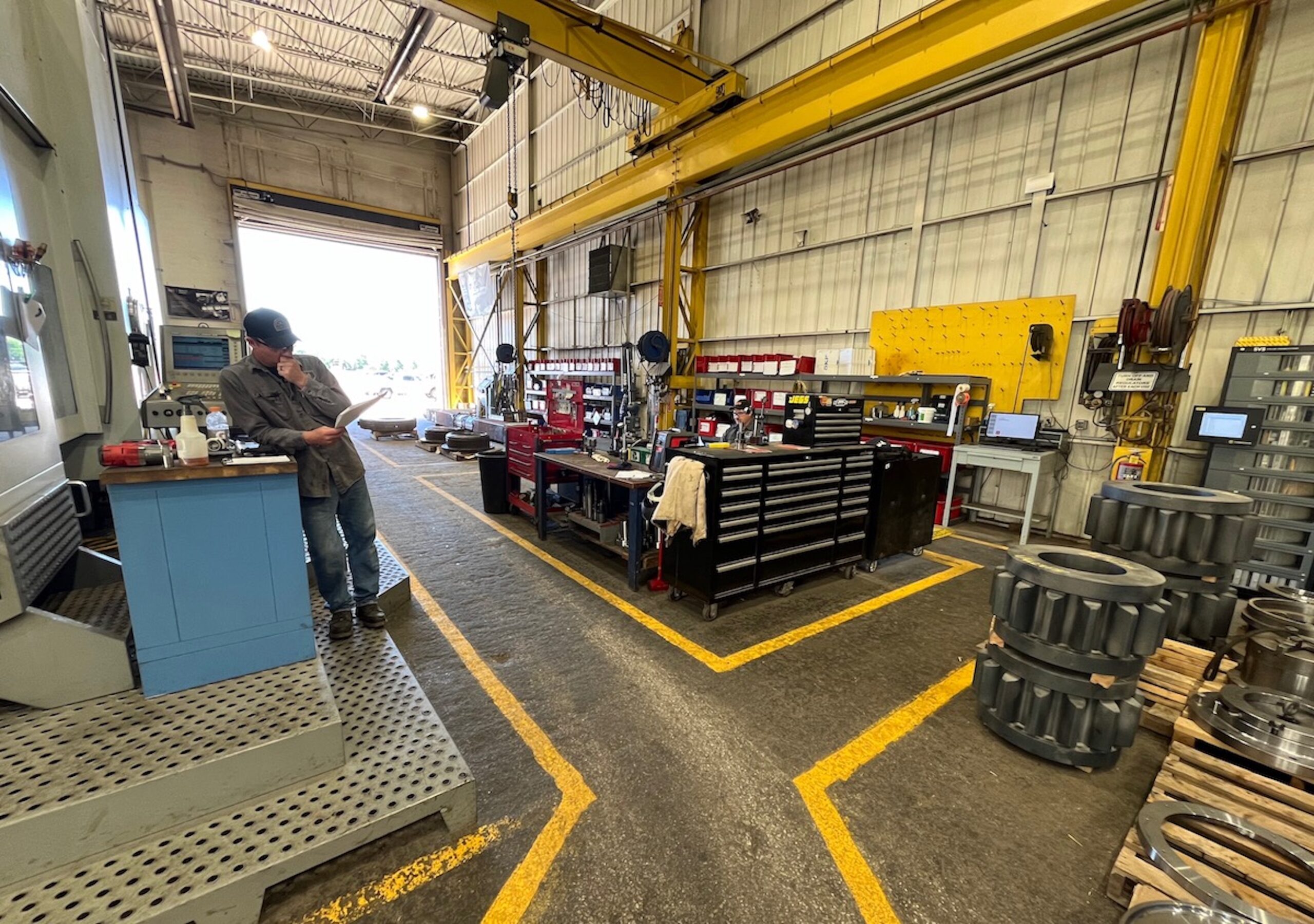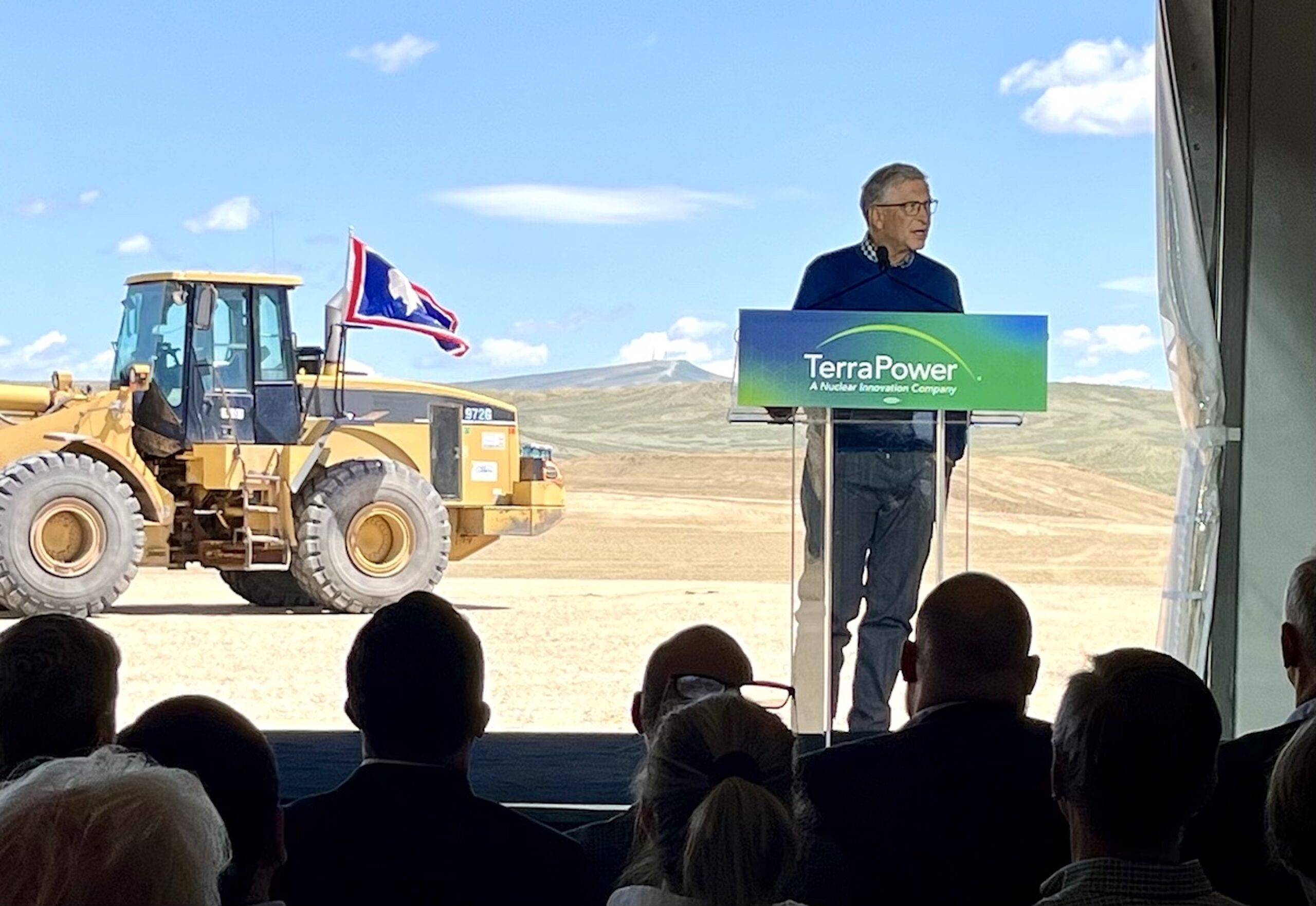Boom-and-bust cycle produced resilient innovators itching for a Wyoming nuclear energy industry

• The state granted $20 million to nuclear energy giant BWXT to establish a microreactor manufacturing base here. A network of sophisticated service and manufacturing shops is added bonus.
By Dustin Bleizeffer, WyoFile.com
GILLETTE—Mike Wandler strolled from shop to shop at L&H Industrial’s complex on the south end of town, recounting how 20 years ago more than a hundred workers would have filled the space — grinders throwing sparks, welders blasting flashes of light and machinists carefully cutting steel at a battery of lathes — during the height of Wyoming’s mining and coal-bed methane boom.
Sure, there was a lot more drilling and mining in northeast Wyoming then compared to today, but L&H Industrial, which began as a tiny welding shop in the mid-1960s, is busier than ever, said Wandler, the company’s president, because it is continually evolving. The buzz in the shop might be more subdued, but business is still good.
Though it continues to serve local coal mines and drilling outfits, the company has expanded both its work and its clientele — far beyond Wyoming’s borders. Today, L&H also designs and manufactures components to serve the renewable energy sector, railroads, the U.S. military and even NASA. It relies more on automation to crank out high volumes of mechanical components.
Next, Wandler says, L&H is preparing to serve what he believes will be a revolution in nuclear energy. And he’s helping organize a group of fellow Wyoming businesses and innovators to ensure the state becomes home to a new microreactor manufacturing industry.
“It’s a matter of national security,” Wandler said, noting that while nations are striving toward net-zero carbon emissions, global demand for electricity is skyrocketing. “Russia and China are [building] microreactors, and a world full of Russian and Chinese microreactors — having them be the dominant energy provider for the world — is not a good world for the U.S. or any of its allies.
“We really don’t have a choice,” he added.

After decades of failed promises to significantly expand its power-generating capacity, the nuclear energy industry is enjoying a moment of renewed enthusiasm — including from President Joe Biden and bipartisan support in Congress — for what it might finally deliver: low-carbon energy in the midst of a climate crisis and increasing demand for electricity.
But this time, the focus is to scale down the reactors. TerraPower’s pilot Natrium nuclear plant project in Kemmerer is an example. Rather than large plants that generate on the order of 2,000 megawatts (which are extremely difficult to permit) TerraPower envisions building smaller units that generate 300-500 megawatts.
There’s also talk of microreactors. They are described as self-contained units that can be factory-produced and easily transported in a semitruck or rail car to wherever they’re needed.
Though many Wyoming leaders have dreamed for decades of hosting large-scale nuclear power plants, today’s concept of microreactors that generate 1 to 20 megawatts of electricity fits nicely with the state’s manufacturing capabilities, according to state officials and local advocates like Wandler.
Wyoming may also provide some of the first microreactor clients. Several of Rocky Mountain Power’s industrial electric customers in the state are considering unplugging from the utility due to a series of rate hikes and relying instead on microreactors to supplement their electricity needs, according to the Wyoming Energy Authority. Tata Chemicals Soda Ash Partners in southwest Wyoming signed a cooperative agreement with BWXT Advanced Technologies last year to potentially be the first in the state to use one or more of its microreactors to “supplement existing power generation resources.”
But first, Wyoming wants to capture the manufacturing market.
Wyoming’s nuclear investment
In June, Gov. Mark Gordon issued the second phase of a $20 million grant to global industrial giant BWXT Advanced Technologies. In return, Lynchburg, Virginia-based BWXT is leveraging the money for more federal dollars and bridging partnerships between it, the state of Wyoming and federal nuclear research programs at the Department of Energy’s Idaho National Laboratory. The partnership aims to organize a network of Wyoming-based companies to launch a Cowboy State microreactor manufacturing industry, and backers hope to add many more like Tata Chemicals to BWXT’s list of customers.
Why Wyoming?
It’s not for the state’s wealth of uranium ore reserves and decades as the nation’s top uranium yellowcake producer — though many state leaders hope those resources eventually become a bigger part of the industry’s fuel supply chain. And it’s not necessarily because of the Bill Gates-backed Natrium nuclear power project in Kemmerer — although that certainly sparked interest in the state, officials say.
Instead, BWXT and state officials say it’s the gumption, innovation and growing sophistication among dozens of Wyoming shops that have evolved to survive the boom-and-bust cycles of the state’s legacy oil, natural gas and coal industries. L&H is often used as a prime example.
“I don’t think there’s any part in those microreactors that we couldn’t take on and build,” Wandler said. And he wants other Wyoming companies to get into the game.
Wyoming’s ‘sticky’ entrepreneurs
Wandler described his years serving on the Wyoming Business Council’s board of directors as “kryptonite” to his entrepreneurial sensibilities. Stuffy rules and divisive politics seemed to get in the way of good ideas that require quick action and sometimes a leap of faith, he said.
He also became frustrated with seeing big corporations come to the state with federal dollars, set up shop, then pull up stakes at the first sign of difficulty. So Wandler established Wyoming Innovative Entrepreneurs, a network for existing Wyoming businesses with leaders “who want to get things done.”
“I would rather have that federal funding go to those businesses born here, with somebody that’s got deep roots here and that’s already an entrepreneur,” Wandler said. “They’re sticky. Whereas somebody from out of state, they’re not very sticky. They’ll be out as soon as it’s not convenient.”
Though fiercely competitive, the 45-plus Wyoming Innovative Entrepreneurs members understand the potential to share resources and even offer recommendations among each other when big work contracts come along, Wandler said. That way, it’s more likely that big project developers like TerraPower and BWXT will award contracts to companies already established in the state.
“They’re like, ‘Oh, I can come and talk to your whole group about this opportunity. I can find somebody to do dirt work, I can find somebody to do fencing, I can find somebody to give me porta-potties and I can find somebody to build all of my parts,’” Wandler said. “It’s much better to have us vetting ourselves and vouching for each other and curating that team.”
When BWXT reached out to state officials expressing interest, Wandler’s group got a phone call.
For the past year, Wyoming Innovative Entrepreneurs and the Wyoming Energy Authority have been introducing BWXT officials to business leaders across the state. The partnership shares information about component manufacturing needs, how to finance necessary equipment purchases and required certifications.
Wyoming Innovative Entrepreneurs has “really taken off with this,” Wyoming Energy Authority Executive Director Rob Creager said. “If we do the manufacturing, then it doesn’t matter if these reactors are deployed in Wyoming or across the globe. A Wyoming company will benefit from it either way.”
Challenges, and congressional support
There are doubters, of course, who point to the nuclear power industry’s long struggle to expand and build new reactors while staying on budget.
“The nuclear industry and its supporters have sold this rhetoric that is loud and persistent,” said David Schlissel, an analyst for the Institute for Energy Economics and Financial Analysis. “They say, ‘The future is not going to be like the past.’ Well, show us. What’s the evidence?”
Schlissel co-authored a report published in May that, based on past projects, casts doubt on the industry’s promise to deploy a new generation of “small modular reactors” like TerraPower’s Natrium project in Kemmerer. Though small modular reactors are still much larger than microreactors, companies hoping to deploy microreactors face many of the same headwinds, he said. Primarily, the long, expensive road to clear Nuclear Regulatory Commission permitting and certifications.
But Congress handed nuclear energy advocates a potentially huge win in June with the passage of the bipartisan Accelerating Deployment of Versatile, Advanced Nuclear for Clean Energy (ADVANCE) Act. In addition to banning nuclear fuel from China and Russia, the law requires the Nuclear Regulatory Commission to expedite its permitting and licensing process, which has complicated new nuclear facilities’ ability to keep costs low and stay on schedule.
Although BWXT says it already has the technical capability to produce microreactors, its timing for manufacturing and deploying them is mostly dependent on NRC permitting.
“The customer timeline, plus the regulatory approval timeline, is what will determine how rapidly we bring these microreactors to the market,” BWXT Advanced Technologies Director of Product Development Erik Nygaard told WyoFile via email.
Even before the ADVANCE Act’s passage in June, the NRC has been streamlining its permitting and certification process for smaller nuclear reactors, including TerraPower’s Natrium project in Kemmerer. The NRC will host a public meeting from 5-7:30 p.m. Tuesday in Kemmerer regarding its environmental review to determine whether to grant TerraPower a construction permit.
WyoFile is an independent nonprofit news organization focused on Wyoming people, places and policy.





